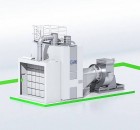Sorption is a fixation process or capture of gas on a vapor called sorbate by a substance in a condensed state. The state can either be solid or liquid and is known as sorbent. The sorptive process is a combination of chemical and physical processes by which any 2 substances become attached.
ROLE OF SORPTIVE PROCESSES IN AIR POLLUTION CONTROL SYSTEMS
The sorptive process is one of the major processes used for air pollution control systems in India by many big industries. In this process, the exhaust air comes into contact with a medium in which the pollutant dissolves more effectively than it does in the air. This leads to the movement of the pollutant towards the medium, leaving the clean and pollutant-free air behind.
The sorptive process is of 2 types –
1) Adsorption Process
2) Absorption Process
ADSORPTION PROCESS
The main objective of this process is to increase the concentration of pollutants. It is specifically required in scenarios where the concentration of the pollutants in the exhaust gas is either medium or low. This process functions primarily by forming a strong bond between the pollutant and the adsorbent. Some of the most commonly used adsorbents are zeolites and activated carbons.
The process of adsorption can take place in 2 separate ways –
1) The fixed bed adsorption process involves the use of several adsorbers alternatively in the adsorption and desorption mode.
2) The second process involves adsorption with a continuously rotating rotor system, consisting of a specially designed concentration rotor.
Dürr also offers carbon adsorption systems for its air pollution control system. It can be used to remove, recover, and purify solvent from the process exhaust air streams. This air pollution control system also features highly efficient distillation equipment for solvent distillation.
ABSORPTION PROCESS
This process involves one substance taking in or dissolving another completely different substance. The pollutant is mostly gas in this process, while the absorption medium can be either liquid or solid.
Gas scrubbing is a standard application in this process. The unwanted combustion pollutants such as sulphur oxide, halogens, and acids are removed directly from the exhaust gas or air.
This phase of gas scrubbing is generally followed by the oxidation process and sometimes also precedes it.
Once all the pollutants have been accumulated, they are then sent to a catalytic or a thermal oxidation system for removal. This leads to the formation of clear air, which is then allowed to leave the system. This is a highly cost-effective and efficient process for purifying exhaust, and after the adsorption process, it will enable the material to be recycled if required.
REGENERATION IN SORPTIVE PROCESSES
After a certain period, the adsorbent needs to be regenerated as it becomes saturated with the pollutants and cannot take in any more materials. This process is called desorption, and it generally uses hot air, steam, or inert gas.
Dürr provides a wide variety of machinery to enhance the air pollution systems across India, like Sorpt.X AC, which helps protect the downstream equipment, improves performance, reduces gas volumes, and increases the production capacity. Sorpt.XSB uses water to remove CO2, H2S, and light siloxanes from the digester, wastewater treatment, landfills, or other biogas streams. It also captures more than 98.5% of the methane and purifies it to pipeline quality natural gas. Similarly, Sorpt.X CD/CC uses adsorption to increase the concentration of the pollution content in the air. It also offers various acid gas removal technologies for air pollution control systems, such as wet scrubbers, wet acid gas absorbers, and dry sorbent injection.
